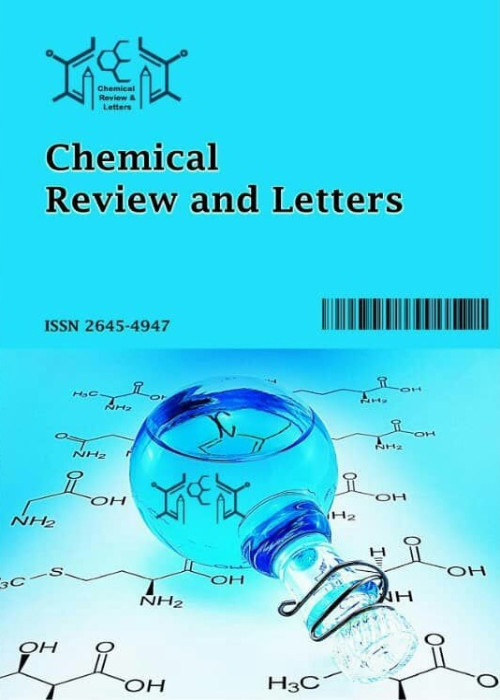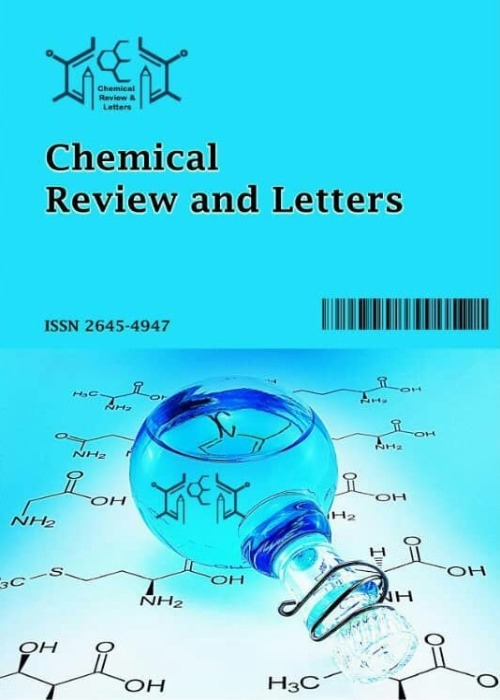فهرست مطالب

Chemical Review and Letters
Volume:7 Issue: 1, Winter 2024
- تاریخ انتشار: 1402/11/12
- تعداد عناوین: 10
-
-
Pages 2-16The effects of non-covalent interactions on the strength and nature of the 5-Aminosalicylic acid complexes and its thio analogous are investigated at the ωB97XD/6-311++G(d,p) level of theory. The atoms in molecules and the natural bond orbital analyses are applied for a better understanding of these interactions. The results show that the cation-π interactions in the monovalent complexes have a stronger influence on the HB strength with respect to those in the divalent complexes. The replacement of oxygen by sulfur atoms increases the hydrogen bond strength in the complexes. Based on the molecular orbital data, the Li+ complexes with the larger energy gap are more stable and harder, while the Mg2+ complexes with the lower energy gap are more reactive and thus softer.Keywords: Cation-π, Intramolecular hydrogen bond, DFT, aim, NBO
-
Pages 17-19
TiO2 photocatalyst by generating electron-hole pairs dissociates the adsorbed water to the reactive oxygen species (ROS) by which environmental pollutants are degraded. There are many experimental and theoretical studies on the band gap reduction of rutile/anatase by single and dual doping of metals and non-metals. In all these works, the dopants are considered to be doped in bulk, and by band gap reduction, the more photocatalytic activity is explained. In this letter, by periodic DFT method, the role of dopants that adsorbed on the surface is studied. To do this, the synergistic effects of Co and N surface doping on the dissociation of water to H+OH radicals are studied.
Keywords: (Co, N) Co-doping, Anatase, Periodic DFT, water dissociation -
Pages 20-30
The direct fluorinative difunctionalization of alkenes is one of the most convenient platforms to the structurally complex organofluorine compounds from bulk chemicals. Accordingly, tremendous efforts to explore synthetic methodologies in this research area have been documented. In this family of reactions, the direct hydroxyfluorination of simple alkenes has emerged as a sustainable and powerful synthetic strategy for the efficient construction of vicinal fluorohydrins, which are found widespread applications in the fields of human life. The purpose of this review is to provide an overview of the available evidence on the synthesis of vicinal fluorohydrins through the direct hydroxyfluorination of corresponding alkenes. Literature has been surveyed from 1999 to the end of October 2023.
Keywords: Difunctionalization, hydroxyfluorination, organofluorine compounds, Alkenes, selectfluor -
Pages 31-44
Ajuga iva is a naturally growing plant in different locations around the world with multiple ethnopharmacological uses. The development of experimental research methods permits exploration and confirmation of the biological properties of Ajuga iva. These biological activities are highly affected by several factors, including the geographical origin of the plant, extraction method, and experimental model. This review collects traditional and modern knowledge regarding the phytochemical composition, pharmacological activities, and toxicological investigations of Ajuga iva. Different extracts prepared using several solvents and extraction methods have been proven to have considerable antioxidant, antidiabetic, antimicrobial, and anti-inflammatory activities in vitro and in vivo. Several bioactive compounds have been identified in Ajuga iva collected from different locations worldwide, including phenolic acids, flavonoids, steroids, terpenoids, and fatty acids, which show various pharmacological activities. The recorded toxicity studies revealed that Ajuga iva is safe and has many folk medicine uses for relieving symptoms of several diseases.
Keywords: Ajuga iva, phytochemistry, biological properties, bioactive compounds -
Pages 45-52In this research work, a serious of novel polymeric prodrugs of mefenamic acid was prepared in order to minimize of the mefenamic acid side effects. Glycidyl methacrylate was first copolymerized with acrylamide and methyl methacrylate by free radical solution polymerization method, using α,ά-azobisisobutyronitrile as an initiator at 70±2 oC. Mefenamic acid, as a non-steroidal anti-inflammatory drug, was then attached to the synthesized copolymers via the hydrolysable ester bonds by transesterification procedure in the presence of N,N'-dicyclohexylcarbodiimide to give polymeric prodrugs. The synthesized copolymers and polymeric prodrugs were characterized by various techniques such as FT-IR, 1HNMR and 13CNMR to confirm their structures. These polymeric prodrugs were hydrolyzed in cellophane membrane dialysis bags containing aqueous buffer solutions (pH 1, 7.4 and 8.5) at 37 oC. Analysis of the hydrolyzing solutions by UV spectrophotometer at selected intervals showed that the drug could be released by selective hydrolysis of the ester bond from side chain of drug moiety. The release profiles of drug indicated that the hydrolytic behavior of polymeric prodrugs strongly depends on the hydrophilicity of polymer and the release rate of mefenamic acid at alkaline medium is higher than other mediums. These developed systems would be useful for the development of pH-sensitive polymeric prodrugs in controlled release systems.Keywords: polymeric prodrugs, Drug delivery systems, Mefenamic acid, Esterification, non-steroidal anti-inflammatory drugs
-
Pages 53-64
The aim of this review is to summarize the available literature on the direct hydroxyazidation of alkenes, with particular emphasize on the mechanistic features of the reactions. The metal-catalyzed reactions are discussed first. This is followed by iodine- and enzyme-catalyzed reactions. Finally, the available examples on light-mediated reactions will be covered at the end of this review.
Keywords: Difunctionalization, hydroxyazidation, β -azido alcohols, Alkenes, carbon-carbon double bonds, biocatalysts -
Pages 65-122
Transition metal complexes incorporating conjugated or non-conjugated azo-azomethine ligands are emergent class compounds in organometallic and catalytic chemistry. Metal complexes with structurally tuneable azo-azomethine ligands have versatile properties and numerous applications in various fields of chemistry. Predominantly, 3d, 4d, and a few 5d transition metal chelates of azo-azomethine ligands with variant features have been reported unequivocally. Geometrical complexity characterizes the rich coordination chemistry of azo-azomethine compounds due to their multiple denticities and the redox non-innocent ligands and metal centres. A detailed literature survey revealed that no brief review has yet been published on azo-imine chemistry with nickel metal. Therefore, the present review article encompasses the research undertaken on the synthetic strategies and coordinating behaviour of various azo-azomethine ligands with nickel metal centres and a few significant properties of metal complexes.
Keywords: Azo-azomethine, Nickel chelates, Multiple denticities, Redox behavior, Bio-logical activity, Thermal stability, NLO property -
Pages 123-133In this work, La2MnFe2O7 and La2CuFe2O7 photocatalysts were synthesized using a co-precipitation method. The surface morphology, structure, crystalline phase and magnetic behavior of the catalysts were investigated by TEM, FT-IR, XRD, DRS, and VSM. The photocatalytic activity of the La2MnFe2O7 and La2CuFe2O7 nanocomposites were appraised using the optical decomposition of malachite green oxalate (MG), methyl violet (MV), and Eriochrome Black T (EBT) beneath ultraviolet (UV) beam irradiance at different factors like the solution pH, dyes’ concentration, catalysts’ amount, temperature and time of UV light radiation. This research provided the synthesis of new composite magnetic photocatalysts and the study of their effectual in the field of photodegradation of dye pollutants.Keywords: Photocatalysts, Malachite green oxalate, Methyl violet, Eriochrome Black T, Co-precipitation
-
Pages 134-141Forensic investigations place significant importance on the identification and utilisation of gasoline in crime scenes, particularly in cases involving arson. This study employed gas chromatography-mass spectrometry (GC-MS) to analyse gasoline samples. Additionally, chemometrics techniques, specifically principal component analysis (PCA), discriminant analysis (DA), and classification and regression tree (CART) machine learning, were utilised to identify and differentiate the gasoline brands and geographical origins. This study encompasses three widely recognized gasoline brands obtained from stations located across eight distinct Malaysian states, which also contains an oil refinery. A novel chromatogram, known as the targeted compounds chromatogram (TCC), was developed. It consists of toluene, p-xylene, propyl benzene, 1-ethyl-2-methylbenzene, mesitylene, and indane, which were identified as markers using factor analysis. The TCC was then applied to fifty-three training samples, resulting in a 94% accurate classification of the brands and locations of origin. A unique machine-learning model called Classification and Regression Tree (CART) was constructed and effectively used to analyse 100 unidentified real gasoline samples. The model achieved a mean absolute error (MAE) of 1.1 for location and 0.4 for brand. Furthermore, the accuracy of the estimator remained consistent even when changes were made to the training data set. The results collected clearly illustrate the capacity of this methodology to assist in solving of criminal investigations.Keywords: Forensic science, Gasoline, arson, chemometrics techniques, Malaysia
-
Pages 142-147
This work explores the replacement of Al3+ by Fe2+ or Fe3+ and the effect of porous agent on geopolymers foam formation, using DFT at the level of theory B3LYP/6-31G+(d, p). The obtained results show values of HOMO-LUMO gaps that are respectively 130.46 ; 93.3 and 14.38 Kcal.mol-1 for [Al(OH)4]-, [Fe(OH)4]- and [Fe(OH)4]2- monomers and; 63.79, 5.65, 155.55 and 36.13 Kcal.mol-1 for oligomers[(OH)2Al–(O–Si(OH)3)2]- , [(OH)2Fe–(O–Si(OH)3)2]- , [Al–(O–Si(OH)3)4]- and Fe–(O–Si(OH)3)4]2-. Calculations using thermodynamics parameter reveals the most favorable porous agent amongst the three (silica fume, aluminum powder and oxygenated water) tested. The results reveal that aluminum powder seems to be the best candidate with the lowest change in G (-190.61 Kcal.mol-1) and S (-82.94 cal/mol.K).
Keywords: Geopolymers, foam, porous agent, DFT, HOMO-LUMO gap


